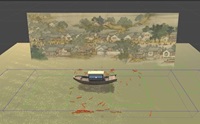
Asia Pacific Academy of Science Pte. Ltd. (APACSCI) specializes in international journal publishing. APACSCI adopts the open access publishing model and provides an important communication bridge for academic groups whose interest fields include engineering, technology, medicine, computer, mathematics, agriculture and forestry, and environment.


LULC changes in the region of the proposed Pwalugu hydropower project using GIS and remote sensing technique
Vol 5, Issue 2, 2024
VIEWS - 20 (Abstract)
Abstract
Proper understanding of LULC changes is considered an indispensable element for modeling. It is also central for planning and management activities as well as understanding the earth as a system. This study examined LULC changes in the region of the proposed Pwalugu hydropower project using remote sensing (RS) and geographic information systems (GIS) techniques. Data from the United States Geological Survey's Landsat satellite, specifically the Landsat Thematic Mapper (TM), the Enhanced Thematic Mapper (ETM), and the Operational Land Imager (OLI), were used. The Landsat 5 thematic mapper (TM) sensor data was processed for the year 1990; the Landsat 7 SLC data was processed for the year 2000; and the 2020 data was collected from Operation Land Image (OLI). Landsat images were extracted based on the years 1990, 2000, and 2020, which were used to develop three land cover maps. The region of the proposed Pwalugu hydropower project was divided into the following five primary LULC classes: settlements and barren lands; croplands; water bodies; grassland; and other areas. Within the three periods (1990–2000, 2000–2020, and 1990–2020), grassland has increased from 9%, 20%, and 40%, respectively. On the other hand, the change in the remaining four (4) classes varied. The findings suggest that population growth, changes in climate, and deforestation during this thirty-year period have been responsible for the variations in the LULC classes. The variations in the LULC changes could have a significant influence on the hydrological processes in the form of evapotranspiration, interception, and infiltration. This study will therefore assist in establishing patterns and will enable Ghana's resource managers to forecast realistic change scenarios that would be helpful for the management of the proposed Pwalugu hydropower project.
Keywords
Full Text:
PDFReferences
1. Quentin FB, Jim C, Julia C, et al. Drivers of land use change, Final report: Matching opportunities to motivations, ESAI project 05116. Royal Melbourne Institute of Technology; 2006.
2. Lambin EF, Geist HJ, Lepers E. Dynamics of Land-Use and Land-Cover Change in Tropical Regions. Annual Review of Environment and Resources. 2003; 28(1): 205-241. doi: 10.1146/annurev.energy.28.050302.105459
3. Chrysoulakis N, Kamarianakis Y, Farsari Y, et al. Combining Satellite and Socio-economic data for Land-use Models estimation. Geography, Environmental Science; 2004.
4. Zubair AO. Change Detection in Land Use and land Cover Using Remote Sensing Data and GIS: A Case Study of Ilorin and Its Environs in Kwara State. Available online: https://www.geospatialworld.net/wpcontent/uploads/2016/04/OpeyemiZubair_ThesisPDF.pdf (accessed on 6 March 2024).
5. FAO (Food and Agriculture Organization of the United Nations). State of the World’s Forests 2005. Available online: https://fao.org/docrep/pdf/007/y5574e/y5574e00.pdf (accessed on 17 March 2024).
6. Mather AS, Needle CL. The relationships of population and forest trends. Geography Journal. 2000; 166(1): 2–13.
7. Campbell DJ, Lusch DP, Smucker TA, et al. Multiple Methods in the Study of Driving Forces of Land Use and Land Cover Change: A Case Study of SE Kajiado District, Kenya. Human Ecology. 2005; 33(6): 763-794. doi: 10.1007/s10745-005-8210-y
8. Briassoulis H. Land Use, Land Cover and Soil Sciences—Land-use, land-cover changes and global aggregate impacts. Available online: https://www.eolss.net/sample-chapters/c19/E1-05-01-07.pdf (accessed on 6 March 2024).
9. Auch RF, Napton DE, Kambly S, et al. The Driving Forces of Land Change in the Northern Piedmont of the United States. Geographical Review. 2012; 102(1): 53-75. doi: 10.1111/j.1931-0846.2012.00130.x
10. Kanianska R, Kizeková M, Nováček J, et al. Land-use and land-cover changes in rural areas during different political systems: A case study of Slovakia from 1782 to 2006. Land Use Policy. 2014; 36: 554-566. doi: 10.1016/j.landusepol.2013.09.018
11. Sanderson MG, Wiltshire AJ, Betts RA. Projected changes in water availability in the United Kingdom. Water Resources Research. 2012; 48(8). doi: 10.1029/2012wr011881
12. Perugini L, Caporaso L, Marconi S, et al. Biophysical effects on temperature and precipitation due to land cover change. Environmental Research Letters. 2017; 12(5): 053002. doi: 10.1088/1748-9326/aa6b3f
13. Mehari M, Melesse M, Jianhua L. The study of land use and land cover (LULC) dynamics and the perception of local people in Aykoleba, Northern Ethiopia. African Journal of Environmental Science and Technology. 2021; 15(7): 282-297. doi: 10.5897/ajest2021.3022
14. Reid RS, Kruska RL, Muthui N, et al. Land-use and land-cover dynamics in response to changes in climatic, biological and socio-political forces: the case of southwestern Ethiopia. Landscape Ecology. 2000; 15: 339-355.
15. Sterling SM, Ducharne A, Polcher J. The impact of global land-cover change on the terrestrial water cycle. Nature Climate Change. 2012; 3(4): 385-390. doi: 10.1038/nclimate1690
16. Trimble SW, Crosson P. U.S. Soil Erosion Rates--Myth and Reality. Science. 2000; 289(5477): 248-250. doi: 10.1126/science.289.5477.248
17. Sala OE, Chapin FS, Armesto JJ, et al., Global Biodiversity Scenarios for the Year 2100. Science. 2000; 287: 1770-1774. doi: 10.1126/science.287.5459.1770 Science 287, 1770
18. Vitousek PM, Aber JD, Howarth RW, et al. Human alteration of the global nitrogen cycle: sources and consequences. Ecological Applications. 1997; 7: 737–750. doi: 10.1890/1051-0761(1997)007[0737:haotgn]2.0.co;2
19. Praveen K, Ganguly S, &Wakchaure R. Environmental pollution and safety measures international issues and its global impact. Global Progress in Development of Sustainable Environment. 2017; 40-65.
20. Gashaw T, Tulu T, Argaw M, et al. Modeling the hydrological impacts of land use/land cover changes in the Andassa watershed, Blue Nile Basin, Ethiopia. Science of The Total Environment. 2018; 619-620: 1394-1408. doi: 10.1016/j.scitotenv.2017.11.191
21. Jaksa WT, Sridhar V. Effect of irrigation in simulating long-term evapotranspiration climatology in a human-dominated river basin system. Agricultural and Forest Meteorology. 2015; 200: 109-118. doi: 10.1016/j.agrformet.2014.09.008
22. Ahiablame L, Sinha T, Paul M, et al. Streamflow response to potential land use and climate changes in the James River watershed, Upper Midwest United States. Journal of Hydrology: Regional Studies. 2017; 14: 150-166. doi: 10.1016/j.ejrh.2017.11.004
23. Welde K, Gebremariam B. Effect of land use land cover dynamics on hydrological response of watershed: Case study of Tekeze Dam watershed, northern Ethiopia. International Soil and Water Conservation Research. 2017; 5(1): 1-16. doi: 10.1016/j.iswcr.2017.03.002
24. Wang B, Yim SY, Lee JY, et al. Future change of Asian-Australian monsoon under RCP 4.5 anthropogenic warming scenario. Climate Dynamics. 2013; 42(1-2): 83-100. doi: 10.1007/s00382-013-1769-x
25. Niraula R, Meixner T, Norman LM. Determining the importance of model calibration for forecasting absolute/relative changes in streamflow from LULC and climate changes. Journal of Hydrology. 2015; 522: 439-451. doi: 10.1016/j.jhydrol.2015.01.007
26. Seong C, Sridhar V. Hydroclimatic variability and change in the Chesapeake Bay Watershed. Journal of Water and Climate Change. 2016; 8(2): 254-273. doi: 10.2166/wcc.2016.008
27. Sridhar V, Wedin DA. Hydrological behaviour of grasslands of the Sandhills of Nebraska: water and energy‐balance assessment from measurements, treatments, and modelling. Ecohydrology. 2009; 2(2): 195-212. doi: 10.1002/eco.61
28. Sridhar V, Anderson KA. Human-induced modifications to land surface fluxes and their implications on water management under past and future climate change conditions. Agricultural and Forest Meteorology. 2017; 234-235: 66-79. doi: 10.1016/j.agrformet.2016.12.009
29. Wang YC, Hu BKH, Myint SW, et al. Patterns of land change and their potential impacts on land surface temperature change in Yangon, Myanmar. Science of The Total Environment. 2018; 643: 738-750. doi: 10.1016/j.scitotenv.2018.06.209
30. Mango LM, Melesse AM, McClain ME, et al. Land use and climate change impacts on the hydrology of the upper Mara River Basin, Kenya: results of a modeling study to support better resource management. Hydrology and Earth System Sciences. 2011; 15(7): 2245-2258. doi: 10.5194/hess-15-2245-2011
31. Woyessa YE, Welderufael WA. Impact of land-use change on catchment water balance: a case study in the central region of South Africa. Geoscience Letters. 2021; 8(1). doi: 10.1186/s40562-021-00204-9
32. Bronstert A, Niehoff D, Bürger G. Effects of climate and land-use change on storm runoff generation: present knowledge and modelling capabilities. Hydrological Processes. 2002; 16(2): 509-529. doi: 10.1002/hyp.326
33. Foley JA, DeFries R, Asner GP, et al. Global Consequences of Land Use. Science. 2005; 309(5734): 570-574. doi: 10.1126/science.1111772
34. Tang Z, Engel BA, Pijanowski BC, et al. Forecasting land use change and its environmental impact at a watershed scale. Journal of Environmental Management. 2005; 76(1): 35-45. doi: 10.1016/j.jenvman.2005.01.006
35. Ott B, Uhlenbrook S. Quantifying the impact of land-use changes at the event and seasonal time scale using a process-oriented catchment model. Hydrology and Earth System Sciences. 2004; 8(1): 62-78. doi: 10.5194/hess-8-62-2004
36. Awotwi A, Yeboah F, Kumi M. Assessing the impact of land cover changes on water balance components of White Volta Basin in West Africa. Water and Environment Journal. 2014; 29(2): 259-267. doi: 10.1111/wej.12100
37. Awotwi A, Anornu GK, Quaye-Ballard JA, et al. Water balance responses to land-use/land-cover changes in the Pra River Basin of Ghana, 1986–2025. CATENA. 2019; 182: 104129. doi: 10.1016/j.catena.2019.104129
38. Chang Y, Hou K, Li X, et al. Review of Land Use and Land Cover Change research progress. IOP Conference Series: Earth and Environmental Science. 2018; 113: 012087. doi: 10.1088/1755-1315/113/1/012087
39. Ayala-Silva T, Gordon G, Heath R. Use of Satellite Data to Study the Impact of Land-Cover/Land-Use Change in Madison County Alabama. American Journal of Applied Sciences. 2009; 6(4): 656-660. doi: 10.3844/ajassp.2009.656.660
40. Rawat JS, Kumar M. Monitoring land use/cover change using remote sensing and GIS techniques: A case study of Hawalbagh block, district Almora, Uttarakhand, India. The Egyptian Journal of Remote Sensing and Space Science. 2015; 18(1): 77-84. doi: 10.1016/j.ejrs.2015.02.002
41. Berrick NOS. What Is Remote Sensing? Available online: https://earthdata.nasa.gov/learn/ backgrounders/remote-sensing (accessed on 12 March 2024).
42. Chaikaew P. Land Use Change Monitoring and Modelling using GIS and Remote Sensing Data for Watershed Scale in Thailand. Land Use - Assessing the Past, Envisioning the Future. Published online March 13, 2019. doi: 10.5772/intechopen.79167
43. Halefom AT, Sisay E, Khare D, et al. Applications of remote sensing and gis in land use/land cover change detection: A case study of WoretaZuria watershed, Ethiopia. Applied Research Journal of Geographic Information System. 2018; 1: 1–9.
44. Abd El-Kawy OR, Rød JK, Ismail HA, et al. Land use and land cover change detection in the western Nile delta of Egypt using remote sensing data. Applied Geography. 2011; 31(2): 483-494. doi: 10.1016/j.apgeog.2010.10.012
45. Dymond JR, Shepherd JD, Newsome PF, et al. Remote sensing of land-use change for Kyoto Protocol reporting: the New Zealand case. Environmental Science & Policy. 2012; 16: 1-8. doi: 10.1016/j.envsci.2011.11.011
46. Md Islam R, Khan NI, Khan Z, Roy B. A three decade assessment of forest cover changes in Nijhumdwip national park using remote sensing and GIS. Environmental Challenges. 2021; 4: 100162.
47. Braimoh AK, Vlek PLG., Scale dependent relationships between land-use change and its determinants in the Volta Basin of Ghana. Earth Interact. 2004; 8: 1–23. doi:10.1175/1087-3562(2004)008.
48. Alo CA, Pontius RG. Identifying Systematic Land-Cover Transitions Using Remote Sensing and GIS: The Fate of Forests inside and outside Protected Areas of Southwestern Ghana. Environment and Planning B: Planning and Design. 2008; 35(2): 280-295. doi: 10.1068/b32091
49. Kusimi JM. Characterizing land disturbance in Atewa Range Forest Reserve and Buffer Zone. Land Use Policy. 2015; 49: 471-482. doi: 10.1016/j.landusepol.2015.08.020
50. Kleeman J, Baysal G, Bulley HNN, Furst C. Assessing driving forces of land use and land cover change by a mixed-method approach in North-Eastern Ghana. Journal of Environmental Management. 2017; 196: 411–442. doi: 10.1016/j.jenvman.2017. 01.053
51. Karki S, Thandar AM, Uddin K, et al. Impact of land use land cover change on ecosystem services: a comparative analysis on observed data and people’s perception in Inle Lake, Myanmar. Environmental Systems Research. 2018; 7(1). doi: 10.1186/s40068-018-0128-7
52. Kpienbaareh D, Oduro Appiah J. A geospatial approach to assessing land change in the built-up landscape of Wa Municipality of Ghana. Geografisk Tidsskrift-Danish Journal of Geography. 2019; 119(2): 121-135. doi: 10.1080/00167223.2019.1587307
53. Oduro Appiah J, Kpienbaareh D, Adomako JAA. Built-up area expansion in the Wa Municipality of Ghana: implications for vegetation cover loss and fragmentation. African Geographical Review. 2021; 41(3): 364-384. doi: 10.1080/19376812.2021.1919532
54. VRA. Pwalugu Multipurpose Dam Project—Environmental Impact Assessment: Scoping Report. Available online: https://www.vra.com/media/2021/50%20MW%20Solar%20Hybrid%20-PMPDP%20-Scoping%20Report%20-%20Final%20Report_online.pdf (accessed on 6 March 2024).
55. GSS (Ghana Statistical Service). 2010 Population and Housing Census: District Analytical Report, Talensi District. Available online: https://www.google.com/url?sa=t&rct=j&q=&esrc=s&source=web&cd=&cad=rja&uact=8&ved=2ahUKEwiS_cD_iZ-HAxUrWUEAHcxnCA8QFnoECCQQAQ&url=https%3A%2F%2Fstatsghana.gov.gh%2Fgssmain%2FfileUpload%2Fpressrelease%2F2021%2520PHC%2520General%2520Report%2520Vol%25203A_Population%2520of%2520Regions%2520and%2520Districts_181121.pdf&usg=AOvVaw0oAt1cZCAn42icD1NZkTkc&opi=89978449 (accessed on 16 March 2024).
56. USGS. EarthExplorer. Available online: https://earthexplorer.usgs.gov/ (accessed on 24 March 2024).
Refbacks
- There are currently no refbacks.
Copyright (c) 2024 Emmanuel Kekle Ahialey, Amos T. Kabo–bah, Samuel Gyamfi
License URL: https://creativecommons.org/licenses/by/4.0/

This site is licensed under a Creative Commons Attribution 4.0 International License (CC BY 4.0).

Prof. Zhigeng Pan
Director, Institute for Metaverse, Nanjing University of Information Science & Technology, China

Prof. Jianrong Tan
Academician, Chinese Academy of Engineering, China

